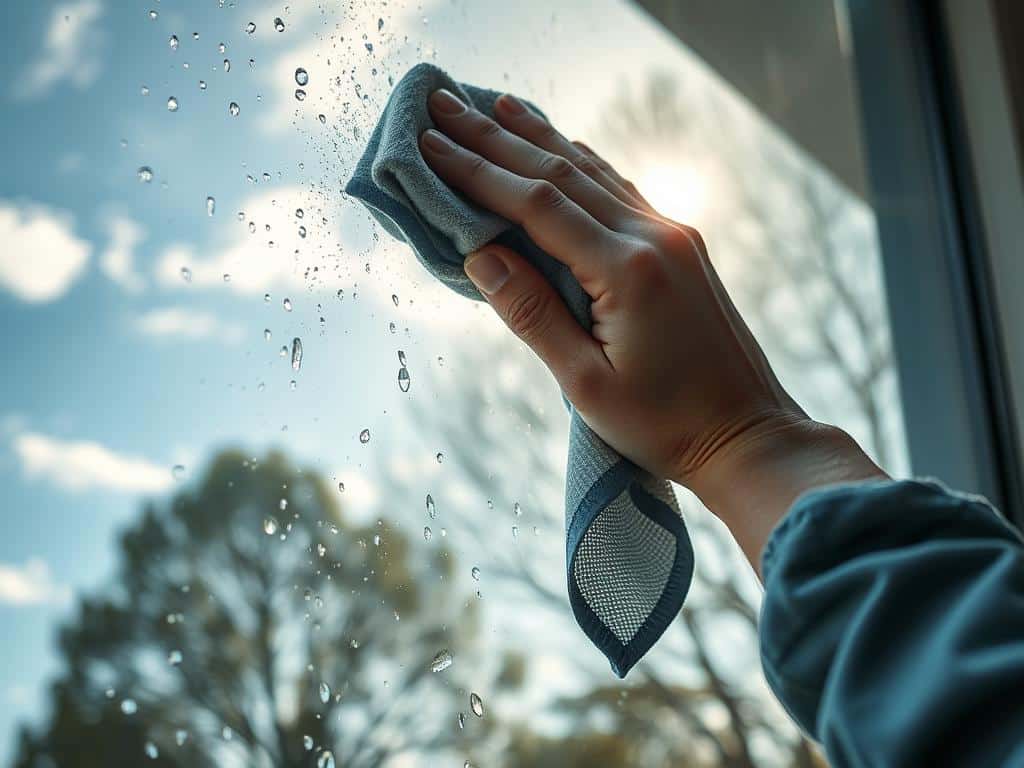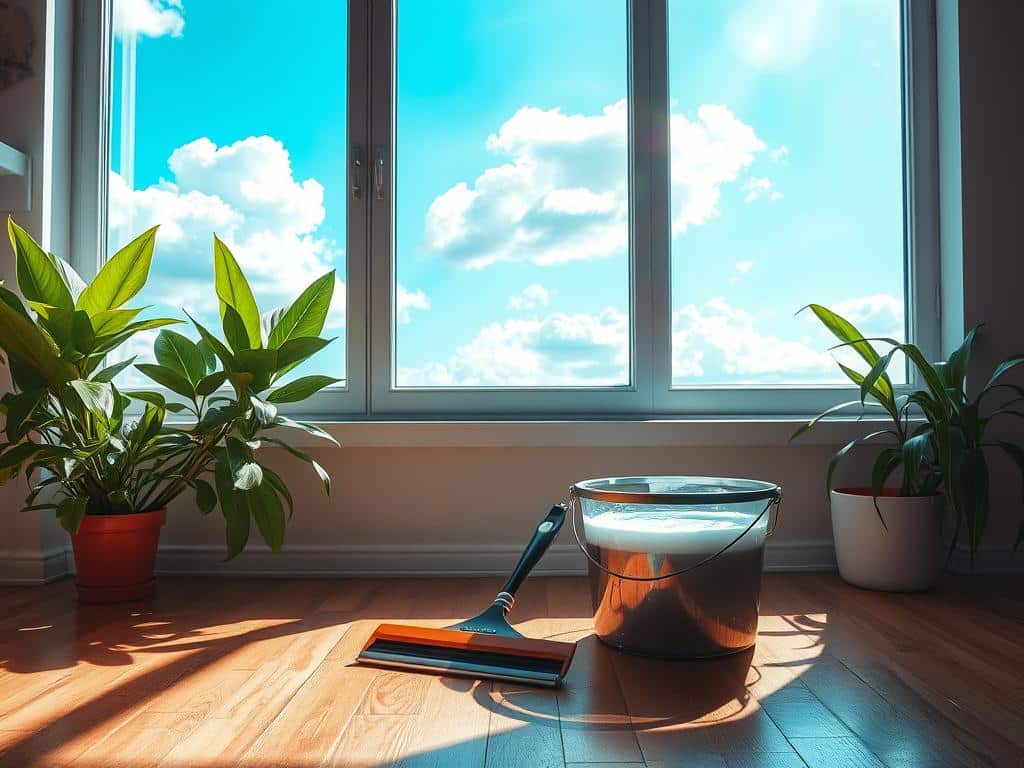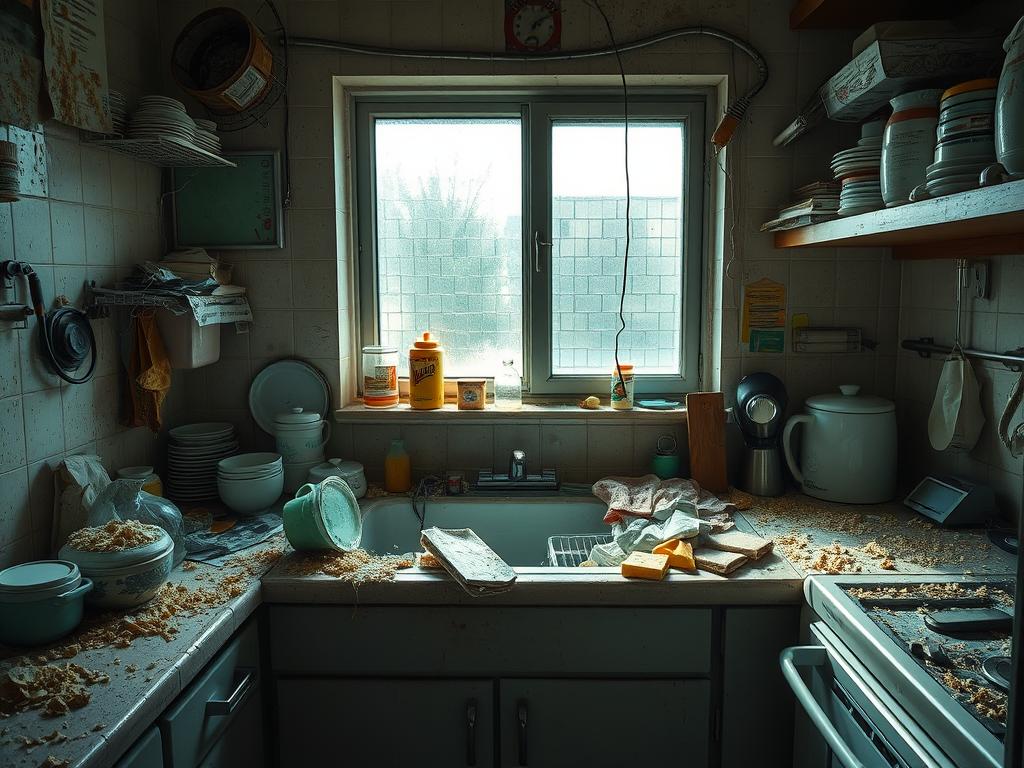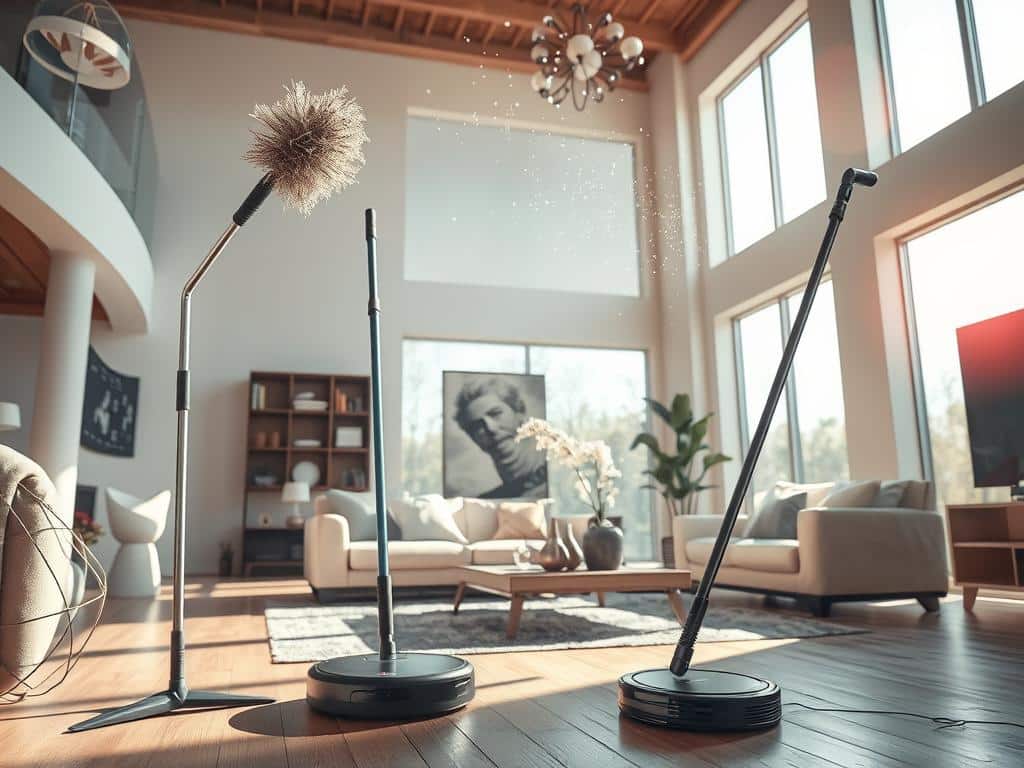
Regular cleaning is crucial for maintaining the quality and clarity of your window glass. Achieving crystal-clear glass cleaning involves using the right materials and techniques. Experts recommend cleaning windows at least twice a year to preserve their appearance and functionality. Clean windows not only enhance the aesthetics of your home but also improve your enjoyment of the external views.
To start your streak-free window cleaning, it’s essential to focus on all components of the window including frames, glass, screens, and blinds. This comprehensive approach uses gentle solutions and proper tools such as a microfiber cloth, chamois, or newspaper to avoid lint streaks.
For a more effective window cleaning, try creating a solution with distilled water to prevent mineral deposits commonly found in hard water. A 50/50 mix of vinegar and water offers a natural and efficient way to achieve streak-free windows. Alternatively, use ammonia by mixing a few tablespoons in a bucket of warm water for a strong cleaning effect. Remember, cleaning one pane at a time provides the best results.
Check out our detailed guide on maintaining clear views with vinyl windows here.
For even better results, adding a few drops of Dawn dish soap to your homemade cleaning solution helps remove tough grime effectively. Additionally, using a squeegee is highly recommended for larger windows to achieve a professional, streak-free finish. Equip yourself with these window maintenance tips to ensure your home’s windows remain spotless and clear year-round.
Preparing Your Own Window Cleaning Solution
Creating your own window cleaning solution is an ideal way to ensure you have a streak-free finish while also saving money. Among the most popular natural window cleaning solutions is the simple combination of distilled white vinegar and water. This homemade window cleaner is both effective and economical, leveraging the acidity of vinegar to break down any film on your glass surfaces. Here’s how you can get started.
DIY Vinegar Solution
A basic homemade window cleaner can be prepared by mixing one part distilled white vinegar with ten parts warm water in a spray bottle. For tougher stains, add a few drops of Dawn dish soap or some rubbing alcohol to enhance the cleaning power. This DIY glass cleaner with vinegar is not only effective but also safe for use around children and pets. For detailed instructions, you might want to check out this homemade window cleaner guide.
Adding Essential Oils for Fresh Scent
While vinegar is excellent for cleaning, it can leave behind a strong odor. To combat this, consider adding a few drops of your favorite essential oil to your homemade window cleaner. Lemon essential oil is particularly popular as it leaves a fresh, citrus scent. Not only will your windows sparkle, but your home will also smell delightful.
Best Practices for Using Commercial Cleaners
Although homemade solutions are incredibly effective, there may be instances where you prefer using commercial cleaners. It’s important to avoid ammonia or alcohol-heavy cleaners as they can leave a residue that attracts dirt and moisture. Instead, opt for natural window cleaning solutions like those with vinegar and water. For instance, some commercial products offer a combination of vinegar and water, mirroring the effectiveness of a DIY glass cleaner with vinegar but with added convenience.
| Product | Use | Cost |
|---|---|---|
| Hose Nozzle/Hand Sprayer | Rinsing windows thoroughly | $15.00 |
| Mr. LongArm Soft Flow-Thru Brush | Scrubbing grime from windows | $30.00 |
| Mr. LongArm Pro-Pole Extension Pole | Reaching high windows | $40.00 |
| Dawn Soap, Blue, 21.6 Fl Oz | Adding to vinegar solution for tough stains | $3.50 |
Remember that homemade window cleaner costs only about $0.30 per bottle to make, compared to at least $3.50 for a similar eco-friendly commercial cleaner. Whether you choose a homemade solution or a natural window cleaning solution from the store, the goal is to achieve those sparkling clean windows without streaks.
Prepping the Windows Before Cleaning
Proper window preparation cleaning is essential to achieving a spotless and streak-free finish. Before you even think about applying any cleaning solutions, it’s crucial to start by cleaning window frames and tracks. This step helps remove any accumulated dirt and debris, preventing them from spreading across the glass during the washing process.
Cleaning Window Tracks and Frames
To effectively clean window tracks and frames, begin by using a soft brush or a vacuum to remove loose dust and dirt. This will help avoid scratching your windows. Afterward, you can wipe down the frames with a damp microfiber cloth, ensuring all nooks and crannies are reached. Microfiber cloths are highly recommended for this task as they are lint-free, absorbent, and eco-friendly.
Handling Stubborn Stains
When it comes to removing window stains, sometimes a bit more than a simple wipe-down is necessary. For stubborn spots, you can use nonabrasive cleaners or solvents like acetone. Mineral spirits or even Pine-Sol® can be effective for cleaning window frames. However, avoid using abrasive methods such as razor blades, which can permanently scratch the glass. Always opt for gentler options to maintain the integrity of your windows. Remember, patience and the right tools are key to successfully removing window stains.
Here’s a helpful table for quick reference on effective cleaners:
| Type of Stain | Recommended Cleaner |
|---|---|
| General Dirt and Debris | Soft Brush, Vacuum, Microfiber Cloth |
| Persistent Spots | Nonabrasive Cleaners, Acetone |
| Stubborn Stains | Mineral Spirits, Pine-Sol® |
By prioritizing window preparation cleaning and effectively handling each component during the process, you can ensure that your windows will be clear, clean, and streak-free. Whether you’re tackling the frames or removing window stains, taking these preparatory steps will make the actual cleaning much more manageable and effective.
The Best Way to Clean Windows for a Streak-Free Finish
Achieving streak-free windows can transform your home’s appearance. A combination of the right tools and techniques guarantees excellent results without the hassle of recurring streaks.
Choosing the Right Cleaning Cloth
When it comes to streak-free window tips, using the right materials is crucial. Microfiber cloths are highly recommended as they are super absorbent and leave no lint behind. By cleaning with microfiber cloths, you ensure all residue is removed effectively. Always apply the cleaner to the cloth rather than spraying it directly on the glass to keep frames safe from damage.
Using a Squeegee for Large Windows
While microfiber cloths are excellent for small to medium-sized windows, larger windows benefit from effective window squeegee techniques. Begin at the top of the window and use a consistent zig-zag motion, wiping the squeegee blade with a dry towel between strokes. This method prevents water spots and ensures an even, streak-free finish.
Cleaning Double-Hung Windows
Double-hung windows typically require extra attention. Start by lowering the top sash to clean the outside, then raise the bottom sash to reach the inside. Employ the same S pattern technique used with microfiber cloths to ensure thorough cleaning. Regularly inspect for any remaining spots or streaks to maintain perfection.
Extra Tips for Maintaining Clean Windows
Achieving spotless, streak-free windows goes beyond just cleaning solutions and tools. Implementing these extra tips can make a significant difference in maintaining the gleam of your windows.
Why Cloudy Days Are Ideal
One of the ideal window cleaning conditions is a cloudy day. Direct sunlight can cause the cleaning solution to evaporate quickly, leading to streaks that are difficult to remove. Cleaning your windows on a mild, overcast day reduces glare and allows you more time to work the solution across the glass before it dries up.
Avoiding Paper Towels
Paper towels are not recommended for cleaning windows because they tend to leave lint behind, which can result in streaks and residue. Instead, opt for lint-free options like coffee filters or microfiber cloths that effectively wipe away the cleaning solution without leaving any traces. These alternatives ensure a much cleaner finish for your windows.
Utilizing Newspaper and Steel Wool
Using newspapers for windows is an old yet effective method to achieve a brilliant shine. Non-glossy, black and white newspaper pages are perfect for buffing windows after wiping off excess cleaning solution, leaving the glass without any streaks. For tough stains and water spots, cleaning windows with steel wool, specifically #000 super fine steel wool, is recommended. This tool gently removes persistent blemishes and leaves the glass spotless.

| Method | Purpose | Recommendation |
|---|---|---|
| Cloudy Day Cleaning | Prevents streaks and quick evaporation | Best for mild overcast days |
| Microfiber Cloths | Avoids lint and streaks | Use instead of paper towels |
| Newspapers | Buffing windows to a shine | Use non-glossy, black and white pages |
| Steel Wool | Removing tough stains | Use #000 super fine variant |
Conclusion
Achieving sparkling windows can significantly enhance the aesthetic appeal of your home while providing a clear view of the outside world. By following the right steps, using an eco-friendly window cleaning solution, and employing proper techniques, you can attain results comparable to professional window cleaning services. It’s essential to remember that consistency and attention to detail play significant roles in keeping your windows spotless.
One effective approach involves using a DIY mixture of two parts water to one part white vinegar, with a few drops of dish soap. This eco-friendly solution not only cleans but also ensures a streak-free finish when used correctly. Avoiding common mistakes such as using too much solution or inappropriate materials like paper towels will help minimize streaks and lint.
Regular maintenance, ideally twice a year, can prevent buildup and maintain clarity. The choice of tools—such as high-quality microfiber cloths and squeegees—also greatly influences the outcome. While cleaning on a sunny, hot day might seem ideal, it’s better to opt for cloudy days to prevent the solution from drying too quickly and leaving streaks.
By investing a little time and using the methods and tips highlighted, you can enjoy the benefits of clear, streak-free windows. For those who prefer to save time or avoid the potential hazards of DIY cleaning, hiring professional window cleaning services remains a valuable option. Remember, each cleaning task improves with practice, leading to more efficient and successful results over time.



